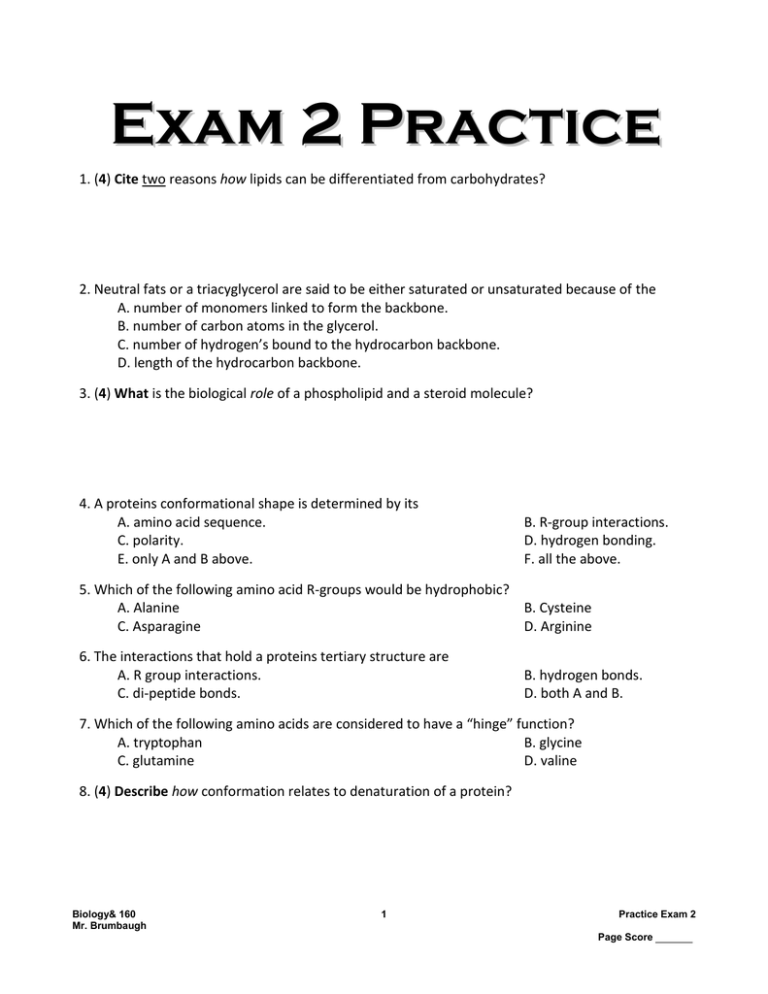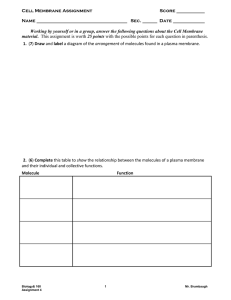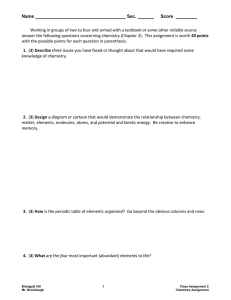E x a m
advertisement

Exam 2 Practice 1. (4) Cite two reasons how lipids can be differentiated from carbohydrates? 2. Neutral fats or a triacyglycerol are said to be either saturated or unsaturated because of the A. number of monomers linked to form the backbone. B. number of carbon atoms in the glycerol. C. number of hydrogen’s bound to the hydrocarbon backbone. D. length of the hydrocarbon backbone. 3. (4) What is the biological role of a phospholipid and a steroid molecule? 4. A proteins conformational shape is determined by its A. amino acid sequence. C. polarity. E. only A and B above. B. R-group interactions. D. hydrogen bonding. F. all the above. 5. Which of the following amino acid R-groups would be hydrophobic? A. Alanine B. Cysteine C. Asparagine D. Arginine 6. The interactions that hold a proteins tertiary structure are A. R group interactions. C. di-peptide bonds. B. hydrogen bonds. D. both A and B. 7. Which of the following amino acids are considered to have a “hinge” function? A. tryptophan B. glycine C. glutamine D. valine 8. (4) Describe how conformation relates to denaturation of a protein? Biology& 160 Mr. Brumbaugh 1 Practice Exam 2 Page Score . 9. (4) Cite four differences used to separate the structure of DNA from RNA? 10. The advantage of phase contrast microscopy over bright-field microscopy is A. viewing cellular density differences. B. magnification. C. resolution. D. cost. 11. (2) What is the advantage of using bright field microscopy over dark field microscopy? 12. Environmental TEM/SEM allows scientist to view with A. higher magnification. C. lower energy costs. B. greater resolution. D. living specimens. 13 The technique of cell fractionalization takes advantage of differences in ? of the cell parts. A. mass B. polarity C. staining C. volume 14. (2) What is the advantage of using antibody stains on cells and where do we find these stains? 15. The strongest force thought to dictate the timing of cell division is the A. surface to volume ratio. B. contact inhibition. C. genetic make-up. D. your MOM. 16. Fungal cells walls are made rigid by the addition of ? in the molecular make-up. A. cellulose B. protein C. lipid material. C. chitin. 17. (2) Explain the role of pectin and hemi-cellulose in the cell wall of plants? Biology& 160 Mr. Brumbaugh 2 Practice Exam 2 Page Score . 18. (6) Draw and label the molecular arrangement of a cell membrane showing the fluid mosaic model? 19. (4)Describe the difference in function for the following organelle pairs: rough vs. smooth Endoplasmic Reticulum Lysosome vs. Peroxisome 20. The protein of the cytoskeleton that functions to change the shape of the cell is called A. microtubules. B. actin microfilaments. C. intermediate filaments. D. both A and C. 21. The cell protein that serves as the core of cilia in a 9 + 2 arrangement is A. microtubules. B. actin microfilaments. C. intermediate filaments. D. both A and C. 22. (2) Describe the function and location of the animal cell junction referred to as a tight junction? Biology& 160 Mr. Brumbaugh 3 Practice Exam 2 Page Score . 23. (2) Explain two "general" functions attributed to the cell membrane? 24. (2) Describe the residue or domain arrangement of membrane integral proteins that allows them to stay within the bilayer and act as channels through the membrane? 25. (3) Describe two factors that could change the fluidity of a cell membrane? 26. (2) Explain two requirements for passive transport to occur across a membrane? 27. If a cell contained 35 A’s and 20 B’s, with only the B’s permeable to its membrane, was placed into a solution containing 35 A’s and 0 B’s, which direction would the water move at equilibrium? A. into the cell B. out of the cell C. water essentially wouldn’t move D. to Auburn Biology& 160 Mr. Brumbaugh 4 Practice Exam 2 Page Score . 28. (2) Compare and contrast facilitated diffusion with active transport as per direction and forces? 29. Boltzman and Einstein both proposed that the energy (ΔG) proposed by Gibbs was due to A. atomic movement. B. balderdash. C. burning fossil fuels. D. Brownian motion. 30. (4) State the first Law of Thermodynamics and explain how cells follow this law. 31. (2) Explain the meaning of the following equation or what does it explain to cell biologists? ΔG = ΔH - TΔS 32. Reactions that release energy to the environment are called ? when they occur. A. helpful B. endergonic C. exergonic D. entropetic 33. (3) Describe what is meant by the phrase “An ATP coupled reaction”? Biology& 160 Mr. Brumbaugh 5 Practice Exam 2 Page Score . 34. The results of the idea that alcohol production needing intact cells controversy at the end of the 1800’s proved that Justus von Leibig was A. incorrect. B. correct. C. through with science. D. a brew master. 35. (2) List two properties or characteristics which all enzymes share? 36. (2) Describe or state two mechanisms by which enzymes are able to lower the activation energy required for favorable reactions to proceed? 37. (2) Explain how a non-competitive inhibitor binding to an enzyme would cause an enzyme to be inactive? 38. (2) Describe two conditions or situations in which an enzyme can be denatured? Biology& 160 Mr. Brumbaugh 6 Practice Exam 2 Page Score . 39. Which of the following sentences describe the effect on an enzymes function due to allosteric binding? A. The binding of one substrate enhances the binding of subsequent substrates in a mega-enzyme. B. The production of one product produced later in an enzyme sequence inhibits an earlier enzyme in the same enzyme sequence. C. The binding of a ligand at one enzyme site enhances the binding of substrate at multiple sites on a mega-enzyme. D. Enzymes named Al only work when married to an Irish enzyme named O’steric. 40. The scientist responsible for figuring out the photosynthetic equation was A. van Helmont. B. Priestly. C. Ingenhous. D. DeSaussure. 41. The scientist responsible for figuring out the photosynthetic organisms needed water was A. van Helmont. B. Priestly. C. Ingenhous. D. DeSaussure. 42. (3) In the left hand side of the following equation circle the molecule that is reduced and underline the molecule that is oxidized? 6CO2 + 6H2O + sunlight C6H12O6 + 6O2 43. (2) Explain why non-visible light energy (U-V or radio waves) don’t stimulate photosynthesis? 44. The metal atom associated with the chlorophyll a molecule is A. iron. C. magnesium. B. copper. D. oxygen. 45. The function of the xanthophyll pigments is thought to be light absorption in the ? range. A. blue B. red C. green D. Out on the Biology& 160 Mr. Brumbaugh 7 Practice Exam 2 Page Score . 46. (6) Draw and label a flow diagram depicting the steps of a non-cyclic photosystem 47. (4) Explain how the cyclic photosystem differs from the non-cyclic photosystem. 48. The molecule used to donate electrons in a plant pigmented photosystem is A. H2O. B. H2S. C. NADPH2. D. any of the above. 49. The enzyme that drives the Calvin-Benson (light independent reactions) is called A. nabisco. B. kinase. C. Mutase. D. rubisco. 50. (3) Describe the role that ATP and NADPH + H+ play in carbon fixation? Biology& 160 Mr. Brumbaugh 8 Practice Exam 2 Page Score . 51. (3) Describe the CO2 fixation logic in C4 plants as per process and timing of stomatal opening versus closing? 52. (2) Cite an example of a plant that follows the photosynthetic strategy called CAM and cite where they would live? Biology& 160 Mr. Brumbaugh 9 Practice Exam 2 Page Score .

